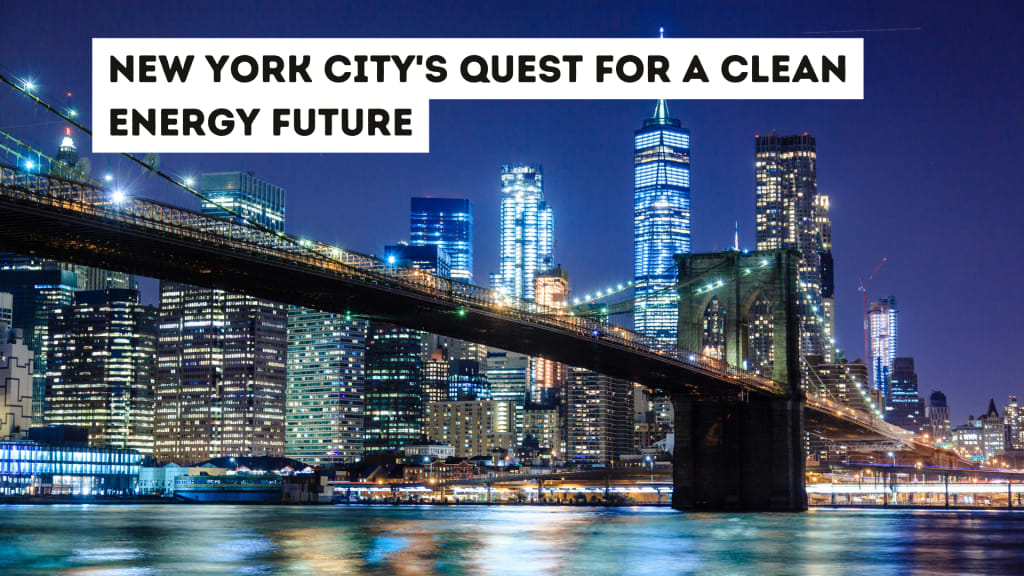New York City's Quest for a Clean Energy Future
A City's Commitment to Sustainability

New York City is a city that never sleeps. It is a place of constant activity and energy, and it is all powered by electricity. The city consumes billions of watts of electricity per day, and it is a major challenge to keep the lights on.
The city's electricity comes from a variety of sources, including fossil fuels, nuclear power, and renewable energy. Fossil fuels, such as coal and natural gas, are the most common source of electricity in the city, but they are also the most polluting. Nuclear power is a cleaner source of electricity, but it is also controversial. Renewable energy, such as solar and wind power, is a growing source of electricity in the city, but it is still not enough to meet the city's needs.
The city's electrical grid is a complex system that is responsible for delivering electricity to homes and businesses. The grid is made up of power plants, transmission lines, and distribution lines. Power plants generate electricity, transmission lines carry electricity from the power plants to the distribution lines, and distribution lines deliver electricity to homes and businesses.
The city's electrical grid is a critical piece of infrastructure, and it is important to keep it reliable. The city has a number of programs in place to ensure the reliability of the grid, including:
Investing in new power plants and transmission lines
Upgrading the distribution lines
Working with businesses and residents to conserve energy
Preparing for natural disasters
The city is also working to transition to a clean energy future. The city has set a goal of reducing greenhouse gas emissions by 80% by 2050. To achieve this goal, the city is investing in renewable energy, energy efficiency, and demand-side management programs.
New York City is a major energy consumer, and it is a challenge to keep the lights on. The city is working to ensure the reliability of its electrical grid and to transition to a clean energy future.
Here are some additional details about how New York City keeps the lights on:
The city's largest power plant is the Ravenswood Generating Station, which is located in Astoria, Queens. The plant has a capacity of 2,400 megawatts, which is enough to power about 2 million homes.
The city's electrical grid is managed by the New York State Electric and Gas Authority (NYSEG). NYSEG is responsible for ensuring that the grid is reliable and that it can meet the city's needs.
The city has a number of programs in place to conserve energy, including:
A program that offers rebates to businesses and residents who install energy-efficient appliances and lighting
A program that provides free energy audits to businesses and residents
A program that offers incentives to businesses and residents who participate in demand-side management programs
New York City is committed to keeping the lights on and to transitioning to a clean energy future. The city is investing in new technologies and programs to achieve these goals.
Here are some of the challenges that New York City faces in keeping its lights on:
The city's growing population is putting a strain on the electrical grid.
The city's reliance on fossil fuels is contributing to climate change.
The city is vulnerable to natural disasters, such as hurricanes and power outages.
Here are some of the things that New York City is doing to address these challenges:
The city is investing in renewable energy, such as solar and wind power.
The city is working to improve the energy efficiency of its buildings.
The city is preparing for natural disasters by hardening its infrastructure and developing emergency plans.
New York City is a leader in the fight against climate change, and it is committed to a clean energy future. The city's investments in renewable energy, energy efficiency, and demand-side management programs are helping to make the city more sustainable and resilient.
Here are some of the benefits of New York City's efforts to transition to a clean energy future:
Reduced greenhouse gas emissions
Improved air quality
Increased energy security
Economic development
Job creation
New York City is a shining example of how a major city can transition to a clean energy future. The city's efforts are helping to create a more sustainable and resilient future for all.
About the Creator
Plantera Digital Media
welcome to my page here i share
- Stories
- Interesting facts about the world around us
- Thought-provoking theories about the nature of reality
- Useful information that can help people in their lives
Enjoyed the story? Support the Creator.
Subscribe for free to receive all their stories in your feed. You could also pledge your support or give them a one-off tip, letting them know you appreciate their work.






Comments
There are no comments for this story
Be the first to respond and start the conversation.